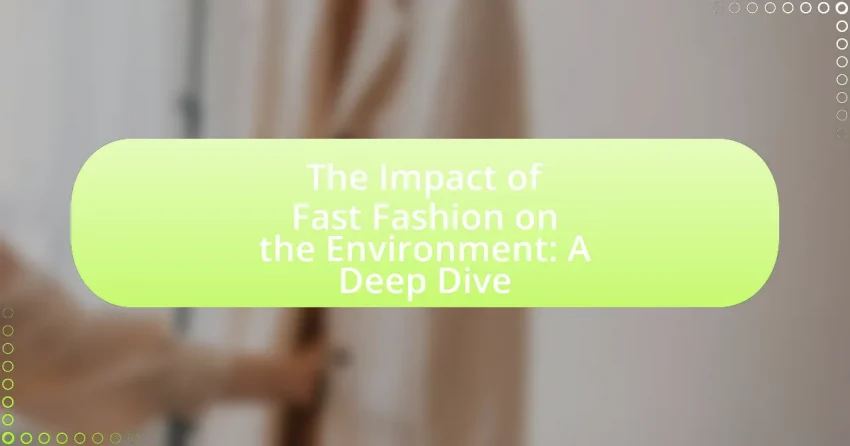The article examines the significant environmental impact of fast fashion, highlighting its contributions to pollution, waste, and resource depletion. It details how the fast fashion industry generates approximately 92 million tons of textile waste annually and is responsible for 20% of global wastewater and 10% of carbon emissions. The discussion includes the excessive resource consumption associated with fast fashion, such as the vast amounts of water required for production, and the detrimental effects on natural ecosystems. Additionally, the article explores consumer behavior’s role in perpetuating fast fashion’s environmental degradation and suggests potential solutions, including sustainable practices and increased awareness, to mitigate its impact.

What is the Impact of Fast Fashion on the Environment?
The impact of fast fashion on the environment is significant, primarily due to its contribution to pollution, waste, and resource depletion. Fast fashion brands produce clothing at an accelerated rate, leading to approximately 92 million tons of textile waste generated annually, as reported by the United Nations. Additionally, the production processes involve toxic chemicals that contaminate water sources, with the fashion industry being responsible for 20% of global wastewater. Furthermore, fast fashion contributes to greenhouse gas emissions, accounting for about 10% of global carbon emissions, which exacerbates climate change. These factors collectively highlight the detrimental effects of fast fashion on environmental sustainability.
How does fast fashion contribute to environmental degradation?
Fast fashion contributes to environmental degradation primarily through excessive resource consumption and waste generation. The industry is responsible for using approximately 93 billion cubic meters of water annually, which is enough to meet the needs of five million people. Additionally, fast fashion produces around 92 million tons of textile waste each year, much of which ends up in landfills. The production processes also release significant greenhouse gases, with the fashion industry accounting for about 10% of global carbon emissions. These factors collectively lead to habitat destruction, pollution, and climate change, underscoring the detrimental impact of fast fashion on the environment.
What are the primary environmental issues caused by fast fashion?
The primary environmental issues caused by fast fashion include excessive waste generation, water pollution, and high carbon emissions. Fast fashion brands produce millions of garments annually, leading to approximately 92 million tons of textile waste each year, much of which ends up in landfills. Additionally, the production processes often involve toxic dyes and chemicals that contaminate water sources, with the fashion industry being responsible for about 20% of global wastewater. Furthermore, fast fashion contributes significantly to climate change, accounting for around 10% of global carbon emissions due to energy-intensive manufacturing and transportation practices.
How does fast fashion affect natural resources?
Fast fashion significantly depletes natural resources by promoting excessive consumption and rapid production cycles. The industry relies heavily on water, with estimates indicating that producing a single cotton shirt requires approximately 2,700 liters of water, enough for one person to drink for two and a half years. Additionally, fast fashion contributes to deforestation, as forests are cleared for cotton farming and synthetic fiber production, which often involves petroleum extraction. The production processes also generate substantial waste and pollution, further straining natural ecosystems. According to the Ellen MacArthur Foundation, the fashion industry is responsible for 20% of global wastewater and 10% of carbon emissions, highlighting its detrimental impact on the environment and natural resources.
Why is fast fashion a growing concern for sustainability?
Fast fashion is a growing concern for sustainability because it leads to excessive waste, resource depletion, and environmental degradation. The fast fashion industry produces over 92 million tons of textile waste annually, contributing significantly to landfill overflow and pollution. Additionally, the production processes consume vast amounts of water and energy; for instance, it takes about 2,700 liters of water to produce a single cotton t-shirt. This unsustainable model not only harms ecosystems but also exacerbates climate change through high carbon emissions associated with manufacturing and transportation.
What role does consumer behavior play in fast fashion’s impact?
Consumer behavior significantly influences fast fashion’s impact on the environment by driving demand for inexpensive, trendy clothing. This demand leads to increased production rates, resulting in higher resource consumption and waste generation. For instance, a study by the Ellen MacArthur Foundation highlights that the fashion industry is responsible for 10% of global carbon emissions, largely due to consumer preferences for rapid turnover of styles. Additionally, consumers often prioritize low prices and quick availability over sustainability, which perpetuates a cycle of overconsumption and environmental degradation.
How does fast fashion compare to traditional fashion in terms of environmental impact?
Fast fashion has a significantly greater environmental impact compared to traditional fashion. Fast fashion contributes to increased waste, as it promotes a cycle of rapid production and consumption, leading to an estimated 92 million tons of textile waste generated annually, according to the Ellen MacArthur Foundation. In contrast, traditional fashion typically emphasizes quality and longevity, resulting in less frequent purchases and reduced waste. Additionally, fast fashion often relies on synthetic materials, which can take hundreds of years to decompose, while traditional fashion may utilize more sustainable fabrics. This difference in material use and production practices highlights the greater ecological footprint of fast fashion.

What are the specific environmental consequences of fast fashion?
Fast fashion leads to significant environmental consequences, including excessive waste, water pollution, and high carbon emissions. The industry generates approximately 92 million tons of textile waste annually, much of which ends up in landfills, where it can take decades to decompose. Additionally, fast fashion production consumes vast amounts of water, with estimates suggesting that producing a single cotton shirt requires around 2,700 liters of water, contributing to water scarcity in many regions. Furthermore, the fast fashion sector is responsible for about 10% of global carbon emissions, primarily due to energy-intensive manufacturing processes and transportation. These statistics highlight the detrimental impact of fast fashion on the environment.
How does fast fashion contribute to pollution?
Fast fashion contributes to pollution primarily through the excessive production and disposal of clothing, which leads to significant environmental degradation. The industry is responsible for approximately 10% of global carbon emissions, largely due to the energy-intensive processes involved in manufacturing and transporting garments. Additionally, fast fashion generates around 92 million tons of textile waste annually, with a substantial portion ending up in landfills, where it can take decades to decompose. The use of synthetic fibers, such as polyester, exacerbates this issue, as they release microplastics into waterways during washing, further polluting oceans and harming marine life.
What types of pollution are associated with fast fashion production?
Fast fashion production is associated with several types of pollution, including water pollution, air pollution, and textile waste. Water pollution occurs due to the discharge of toxic dyes and chemicals used in the manufacturing process into rivers and oceans, affecting aquatic ecosystems. Air pollution arises from the emissions of volatile organic compounds (VOCs) and greenhouse gases during production and transportation, contributing to climate change. Additionally, textile waste pollution results from discarded clothing, with an estimated 92 million tons of textile waste generated globally each year, much of which ends up in landfills. These pollution types highlight the significant environmental impact of fast fashion.
How does waste from fast fashion affect landfills and oceans?
Waste from fast fashion significantly contributes to the overflowing of landfills and the pollution of oceans. Approximately 92 million tons of textile waste are generated globally each year, with a substantial portion ending up in landfills, where synthetic fibers can take up to 200 years to decompose. This accumulation not only occupies valuable land but also releases harmful greenhouse gases during decomposition. Additionally, fast fashion waste often finds its way into oceans, with an estimated 640,000 tons of microfibers entering marine environments annually, leading to detrimental effects on marine life and ecosystems. These statistics highlight the severe environmental impact of fast fashion waste on both landfills and oceans.
What is the carbon footprint of fast fashion?
The carbon footprint of fast fashion is estimated to be around 2.1 billion metric tons of CO2 equivalent annually, which accounts for approximately 10% of global greenhouse gas emissions. This significant impact arises from various stages of the fast fashion lifecycle, including raw material extraction, manufacturing, transportation, and disposal. For instance, the production of synthetic fibers, commonly used in fast fashion, releases substantial amounts of CO2, with polyester alone contributing about 706 million metric tons of CO2 emissions each year. Additionally, the rapid turnover of clothing leads to increased waste, as discarded garments often end up in landfills, where they can take decades to decompose, further exacerbating the carbon footprint.
How do manufacturing and transportation contribute to carbon emissions?
Manufacturing and transportation significantly contribute to carbon emissions through energy-intensive processes and fossil fuel reliance. The manufacturing sector, particularly in fast fashion, is responsible for approximately 10% of global carbon emissions, primarily due to the use of energy from non-renewable sources in textile production and processing. Transportation, which includes shipping and logistics, adds another 7% to global emissions, as it often relies on diesel and other fossil fuels for moving goods. Together, these sectors exacerbate climate change by releasing large quantities of carbon dioxide and other greenhouse gases into the atmosphere, highlighting the urgent need for sustainable practices in both manufacturing and transportation.
What measures can be taken to reduce the carbon footprint of fast fashion?
To reduce the carbon footprint of fast fashion, brands can implement sustainable practices such as using eco-friendly materials, optimizing supply chains, and promoting circular fashion. Eco-friendly materials, like organic cotton and recycled polyester, significantly lower greenhouse gas emissions compared to conventional fabrics. For instance, the production of organic cotton can reduce carbon emissions by up to 46% compared to conventional cotton. Optimizing supply chains by sourcing materials locally and improving transportation efficiency can further decrease emissions associated with logistics. Additionally, promoting circular fashion through recycling and upcycling initiatives helps minimize waste and encourages consumers to extend the lifecycle of garments, thereby reducing the overall demand for new production. These measures collectively contribute to a substantial reduction in the carbon footprint of the fast fashion industry.

What are the potential solutions to mitigate the environmental impact of fast fashion?
To mitigate the environmental impact of fast fashion, implementing sustainable practices such as using eco-friendly materials, promoting circular fashion, and enhancing consumer awareness is essential. Eco-friendly materials, like organic cotton and recycled polyester, reduce resource consumption and pollution during production. Circular fashion encourages recycling and upcycling of garments, which minimizes waste and extends the lifecycle of clothing. Additionally, increasing consumer awareness through education on the environmental consequences of fast fashion can drive demand for sustainable alternatives, leading to more responsible purchasing behaviors. These solutions collectively aim to reduce the carbon footprint and resource depletion associated with the fast fashion industry.
How can consumers make more sustainable fashion choices?
Consumers can make more sustainable fashion choices by prioritizing brands that use eco-friendly materials and ethical production practices. Research indicates that the fashion industry is responsible for 10% of global carbon emissions, highlighting the importance of selecting sustainable options. By choosing clothing made from organic cotton, recycled materials, or sustainable fibers like Tencel, consumers can significantly reduce their environmental impact. Additionally, supporting brands that are transparent about their supply chains and labor practices further promotes sustainability. According to a 2021 report by the Ellen MacArthur Foundation, shifting to a circular economy in fashion could reduce greenhouse gas emissions by 44% by 2030, underscoring the effectiveness of informed consumer choices.
What are the benefits of choosing sustainable brands over fast fashion?
Choosing sustainable brands over fast fashion significantly reduces environmental impact. Sustainable brands prioritize eco-friendly materials and ethical production practices, which minimize waste and pollution. For instance, the fashion industry is responsible for 10% of global carbon emissions, while sustainable brands often utilize organic or recycled materials, which can reduce emissions by up to 50%. Additionally, sustainable brands typically ensure fair labor practices, contributing to social equity, whereas fast fashion often exploits workers in developing countries. By supporting sustainable brands, consumers can help decrease the demand for harmful production methods and promote a more responsible fashion industry.
How can recycling and upcycling help reduce fast fashion’s impact?
Recycling and upcycling can significantly reduce fast fashion’s impact by minimizing waste and conserving resources. Recycling transforms discarded textiles into new materials, thereby reducing the demand for virgin resources and lowering the environmental footprint associated with production. For instance, the Ellen MacArthur Foundation reports that recycling one ton of textiles can save approximately 20,000 liters of water and reduce carbon emissions by 50%. Upcycling, on the other hand, creatively repurposes old garments into new products, extending their lifecycle and reducing the need for new clothing production. This practice not only diverts waste from landfills but also promotes sustainable consumption habits. Together, these methods contribute to a circular economy, which is essential for mitigating the negative environmental effects of fast fashion.
What role do governments and organizations play in addressing fast fashion’s impact?
Governments and organizations play a critical role in addressing fast fashion’s impact by implementing regulations and promoting sustainable practices. Governments can enforce laws that limit waste, such as the European Union’s Circular Economy Action Plan, which aims to reduce textile waste and encourage recycling. Organizations, including NGOs and industry coalitions, advocate for ethical labor practices and environmental standards, exemplified by initiatives like the Fashion Industry Charter for Climate Action, which commits signatories to reduce greenhouse gas emissions. These actions collectively aim to mitigate the environmental degradation and social injustices associated with fast fashion.
What policies can be implemented to regulate fast fashion practices?
Policies that can be implemented to regulate fast fashion practices include stricter environmental regulations, mandatory transparency in supply chains, and incentives for sustainable practices. Stricter environmental regulations can limit waste and pollution generated by fast fashion companies, as seen in the European Union’s Circular Economy Action Plan, which aims to promote sustainable product design and reduce textile waste. Mandatory transparency in supply chains would require brands to disclose their sourcing and production processes, helping consumers make informed choices and holding companies accountable for unethical practices. Additionally, providing incentives for sustainable practices, such as tax breaks for companies that use eco-friendly materials or adopt circular business models, can encourage the industry to shift towards more sustainable operations.
How can awareness campaigns influence consumer behavior towards sustainable fashion?
Awareness campaigns can significantly influence consumer behavior towards sustainable fashion by educating individuals about the environmental impacts of fast fashion and promoting eco-friendly alternatives. These campaigns often utilize statistics and compelling narratives to highlight issues such as textile waste, pollution, and unethical labor practices associated with fast fashion, which can lead consumers to reconsider their purchasing habits. For instance, a study by the Ellen MacArthur Foundation found that educating consumers about the lifecycle of clothing can increase their willingness to buy sustainable products by 30%. By fostering a sense of responsibility and urgency, awareness campaigns can shift consumer preferences towards brands that prioritize sustainability, ultimately driving demand for eco-friendly fashion choices.
What practical steps can individuals take to combat the impact of fast fashion?
Individuals can combat the impact of fast fashion by adopting sustainable shopping habits. This includes choosing to buy second-hand clothing, which reduces demand for new production and minimizes waste; approximately 92 million tons of textile waste are generated globally each year, highlighting the urgency of this approach. Additionally, individuals can support ethical brands that prioritize sustainable practices, such as using eco-friendly materials and fair labor conditions. Research indicates that consumers can significantly influence the fashion industry by shifting their purchasing power towards brands that demonstrate environmental responsibility. Lastly, practicing mindful consumption by purchasing fewer, higher-quality items can lead to a more sustainable wardrobe, as studies show that extending the lifespan of clothing by just nine months can reduce its environmental impact by up to 30%.
